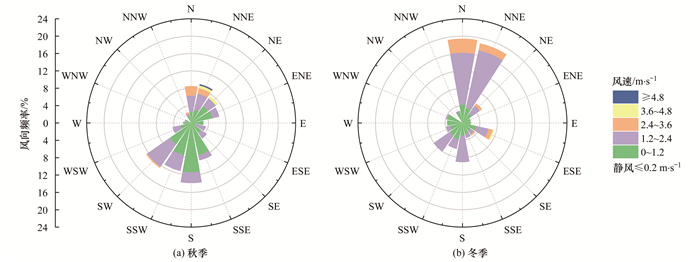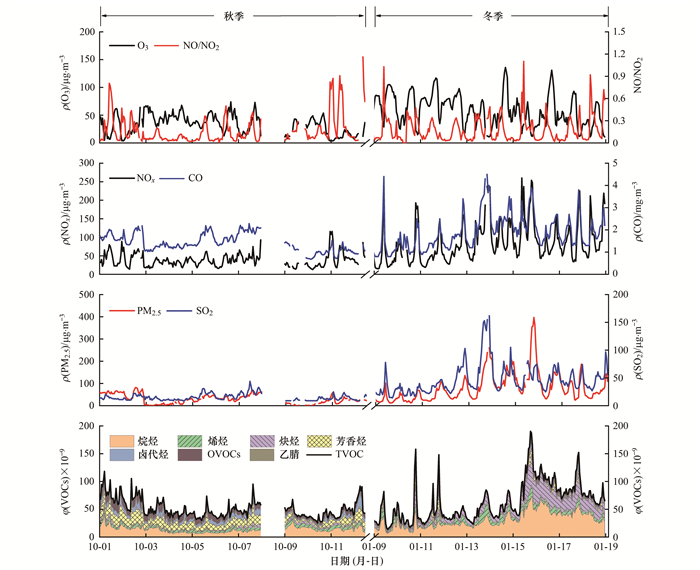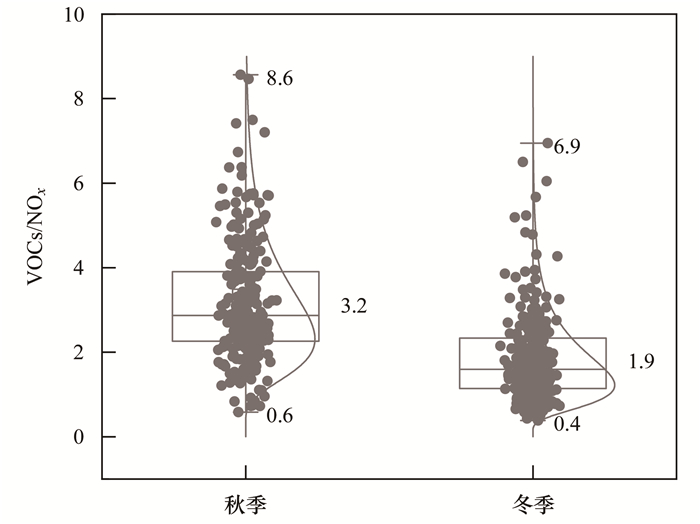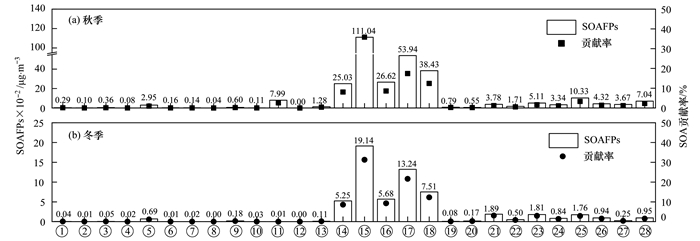2. 长安大学旱区地下水文与生态效应教育部重点实验室, 西安 710064
2. Key Laboratory of Subsurface Hydrology and Ecological Effects in Arid Region, Ministry of Education, Chang'an University, Xi'an 710064, China
大气中的挥发性有机物(VOCs)在光化学反应下可形成臭氧(O3)和二次有机气溶胶(secondary organic aerosol, SOA), 而含不同类型官能团的VOCs在大气中形成二次光化学氧化剂O3和SOA的作用不同[1].按官能团的不同, VOCs可分为烷烃、烯烃、炔烃、芳香烃、卤代烃、醛和酮等.研究不同官能团的VOCs对O3和SOA的生成潜势具有重要意义.
国内一些学者基于VOCs和O3的观测数据, 对一些城市区域开展了大量研究.烷烃仍是北京[2, 3]、天津[4~6]、南京[7, 8]、深圳[9, 10]、成都[11]、太原[12]和珠三角[13]等地区VOCs中含量最多的组分.但目前也有研究表明一些其他VOCs组分是VOCs中含量最多的组分, 重庆主城区[14]VOCs中OVOCs含量最高(38.91%); 济源市疫情防控期间OVOCs含量最多(41.6%)[15], 相比疫情防控前OVOCs的占比增加31.4%; 连云港市不同功能区的VOCs的组分占比有类似性[16], 都以醛酮含量最多(39.29% ~45.94%); 桂林VOCs中芳烃含量最高(65.75%)[17].烯烃和芳香烃仍是大多数地区O3生成活性最大的物种, 芳香烃对SOAFPs的贡献仍最大.陕西关中平原作为全国空气污染防治的重点区域也开展了相关研究, 但主要集中在省会城市西安.Song等[18]的研究表明西安市VOCs中烷烃(25.7% ~39.7%)和OVOCs(22.8% ~47.4%)含量占优势, 乙烯、乙醛、异戊二烯和间/对-二甲苯是西安OFPs的最大贡献者, 贡献率为44.2% ~54.5%.来源解析结果表明, 机动车排放是西安市VOCs的主要来源.Liu等[19]的研究发现西安市O3日平均浓度范围为1~120.3μg ·m-3, 年平均浓度为37.2μg ·m-3, O3的生成受VOCs控制.Sun等[20, 21]利用HERM和PMF模型分别对西安夏季VOCs进行源解析, 表明机动车尾气排放是VOCs最大来源.李琦等[22]和闫东杰等[23]分别编制了西安市2016年和2014年的VOCs排放清单, 2016年VOCs人为源排放总量为119.187×103 t, 2014年为115.1×103 t, 其中有机溶剂的使用对西安市VOCs贡献最大.此外还有学者对关中的渭南市[24]和宝鸡市[25, 26]进行研究.铜川市位于关中平原向陕北黄土高原的过渡地带, 地势西北高、东南低, 地势相差悬殊, 容易引起污染物的积聚.相对于关中平原其他城市, 铜川空气污染物浓度低, 属于相对清洁城市, 但目前尚未有铜川市VOCs特征及O3和SOA生成潜势的研究.因此本研究在铜川市秋冬季开展VOCs浓度和成分的观测分析, 识别生成O3和SOA的关键物种, 以期为精准减排, 改善环境空气质量提供技术依据.
1 材料与方法 1.1 观测地点观测地点位于铜川市生态环境局(东经108°57′18″, 北纬34°53′53″, 海拔高度710 m, 图 1), 采样高度距地面2.5 m.该测点位于铜川市中心, 具有典型的城区特点, 周围分布着居民区、商业区和文教区.观测点东北方3 km处有一印刷厂, 西南方7.8 km处有一电厂, 西北方12.5 km处有一煤厂.观测点距离东南方的G65高速公路和G210国道约2.9 km, 距离西南方的G65W高速公路约4.4 km.观测点周边多种混合污染源的环境现状能够较好地代表典型的城市功能混合环境.

|
图 1 铜川市采样点地理位置示意 Fig. 1 Sampling site in Tongchuan in this study |
VOCs的观测在2017年10月和2018年1月进行.秋季的采样时间为2017年10月1~12日(共11 d, 10月8日数据丢失), 冬季采样时间为2018年1月9~18日(共10 d), 每日24 h连续采样, 采样时间间隔为1 h.
VOCs样品采用TH-300B大气环境挥发性有机物(C2~C12)在线监测系统(武汉天虹, 中国)进行采样与分析.环境空气通过采样系统采集后, 进入浓缩系统, 在超低温条件下, 空气中的VOCs在空毛细管捕集柱中被冷冻捕集; 然后快速加热解析, 使化合物进入GCMS分析系统; 经色谱柱分离后被FID和MS检测器检测. TH-300B采用电制冷超低温冷阱+FID/MS双路检测专利技术, 具有检出限低、重复性好, 数据完整性高和色谱分辨率高的优点.TH-300B在线监测系统, 1 h采集一次空气样品, 每次采样5 min, 流量为60mL ·min-1, 每个样品的采样分析周期为1 h, 质量控制与标定详见文献[11].
在VOCs采样期间, 常规空气质量因子和气象要素的观测点位于铜川市新区管委会(东经108°56′04″, 北纬34°54′21″), 距离VOCs观测点1.6 km.数据来源于中国环境监测总站“全国城市空气质量实时发布平台”(http://106.37.208.233:20035/).
1.3 分析方法 1.3.1 OFP本文共有93种VOCs参与OFP计算:

|
(1) |
式中, OFPi是VOC种类i的O3生成潜势, 10-9; [VOC]i是VOC种类i的实测体积分数, 10-9; MIRi是VOC种类i的最大增量反应活性系数[27].
1.3.2 动力学模拟(EKMA)经典动力学模拟法(empirical kinetics modeling approach, EKMA)可描述O3与前体物之间的敏感性关系.具体方法见文献[28, 29].
1.3.3 SOAFP本研究中SOA与VOCs浓度之间的关系通过实验建立, 可避免考虑VOCs生成SOA复杂反应的具体过程.本文基于Grosjean的烟雾箱实验[30], 采用气溶胶生成系数(FAC)[30, 31]来估算VOCs的SOAFP.本文共有28种VOCs参与SOAFP计算:

|
(2) |
式中, SOAFPi是VOC种类i的SOA生成潜势, μg ·m-3; [VOC]i是VOC种类i的质量浓度, μg ·m-3; FVOCi是VOC种类i参与反应的分数, %; FACi是VOC种类i的SOA生成系数, %.

|
(3) |
式中, Ci是VOC种类i的环境体积分数, 10-9; Mi是VOC种类i的相对分子质量.
2 结果与讨论 2.1 观测期间气象条件秋季观测期间, 在采样点测得的平均气温为12.2℃, 相对湿度为77.0%; 冬季测得的平均气温为-0.6℃, 相对湿度为43.6%(表 1).两季观测期间风速均小于1.5 m ·s-1, 风向与铜川川道走向一致, 秋季主导风为西南风, 冬季主导风为北风(图 2).在这种小风、污染物传输过程较弱, 气温与相对湿度差异较大的气象条件下测得的VOCs能够较好地表征城市VOCs排放特征和季节变化对VOCs浓度的影响.
|
|
表 1 观测期间测点温度、相对湿度、风速、气压、光照和紫外辐射 Table 1 Temperature, relative humidity, wind direction, wind speed, air pressure, solar radiation, and ultraviolet radiation during the observation period in Tongchuan |

|
图 2 铜川市观测期间风速与风向 Fig. 2 Wind rose diagram during Tongchuan observation period |
铜川市观测期间共测得102种VOCs成分, 依据官能团的不同, 大致分为7类, 包括29种烷烃、12种烯烃、1种炔烃、16种芳香烃、31种卤代烃、12种OVOCs和乙腈.用TVOC代表观测期间测出的102种VOCs的总体积分数, 铜川市秋季φ(TVOC)为(50.52±16.81)×10-9, 冬季为(63.21±35.24)×10-9.同期测得的其他常规空气污染物, 秋季ρ(NOx)、ρ(CO)、ρ(PM2.5)和ρ(SO2)分别为: (39.37±20.04)μg ·m-3、(1.41±0.39)mg ·m-3、(30.43±20.82)μg ·m-3和(15.16±5.89)μg ·m-3, 冬季分别为: (87.16±55.24)μg ·m-3、(1.89±0.78)mg ·m-3、(82.56±66.83)μg ·m-3和(46.33±26.01)μg ·m-3(图 3).秋季ρ(O3)为(34.17±18.08)μg ·m-3, 冬季为(58.59±28.59)μg ·m-3(图 3).冬季高前体物浓度(VOCs和NOx)导致冬季O3浓度更高.

|
图 3 铜川市观测期间O3、NO/NO2、NOx、CO、PM2.5、SO2和TVOC时间序列 Fig. 3 Times series of O3, NO/NO2, NOx, CO, PM2.5, SO2, and TVOC during the observation period in Tongchuan |
观测期间φ(TVOC)峰值出现在1月15日18:00, 为190.27×10-9, ρ(O3)峰值出现在1月14日16:00, 为136μg ·m-3, ρ(PM2.5)峰值出现在1月15日19:00, 为397μg ·m-3.秋季和冬季NO/NO2比值分别为0.169和0.178.间/对-二甲苯和乙苯的来源相似且排放比率恒定, 秋季和冬季X/E的比值分别为2.04和2.11(X/E < 3), 表明VOCs大部分来自城市人为排放过程[32~34].
图 4为冬季观测期间污染物(NOx、O3、NO、NO/NO2、NO2和VOCs)浓度、光照和紫外辐射强度的日变化.可见, 冬季观测期间, φ(TVOC)呈单峰型, 峰值出现在19:00, 为(106.48±52.56)×10-9.O3日变化趋势呈单峰型, 峰值出现在16:00, 日间浓度高夜间浓度低.日间平均最高ρ(O3)为(98.3±25.4)μg ·m-3, 夜间平均最低为(31.1±23.5)μg ·m-3.早晨07:00~08:00太阳升起, 伴随着太阳辐射的增强与O3前体物(VOCs和NOx)排放增加, 光化学反应增强, O3浓度开始上升, 至16:00 O3峰值浓度出现. 17:00后随着光照、紫外线趋弱, 气温逐渐下降, 光化学反应产生O3的驱动力减弱, 加之O3自身的汇过程与扩散导致其浓度逐步下降.

|
图 4 铜川市冬季观测期间NOx、O3、NO、NO/NO2、NO2、VOCs、光照和紫外辐射的日变化 Fig. 4 Diurnal variation in NOx, O3, NO, NO/NO2, NO2, VOCs, sun radiation, and ultraviolet radiation during the observation period in Tongchuan |
在07:00~10:00时段ρ(NO)和ρ(NO2)逐渐上升至峰值(33.50μg ·m-3和69.70μg ·m-3), 峰值处NO/NO2的比值为0.44, 这可能受机动车早高峰排放增加影响. 10:00后浓度开始下降, 由于光照与气温的增强, 反应速率增强, NO和NO2作为主要光化学反应前体物而被消耗, 浓度逐渐降低.在18:00~21:00时段NO2、NO浓度和NO/NO2比值升高, 且NO2浓度处于一个较高水平, 这主要与机动车晚高峰排放增加及光化学消耗减少有关.
2.2.2 VOCs成分分析观测期间铜川市秋季和冬季大气中的φ(TVOC)分别为(50.52±16.81)×10-9和(63.21±35.24)×10-9.乙腈是本研究中唯一检测到的含氮化合物, 是生物质燃烧的示踪剂[35], 秋冬季φ(乙腈)分别为0.61×10-9和0.20×10-9.
观测期间秋季和冬季各VOCs组分的体积分数及贡献率见表 2.铜川市秋季大气VOCs中的主要成分为26.19%的烷烃和26.04%的芳香烃, 冬季为48.88%的烷烃.通常乙烷来源于汽油车尾气和天然气挥发; 丙烷和丁烷来源于汽车尾气和液化石油气挥发; 异戊烷和正戊烷来源于汽油车尾气/挥发, 环戊烷来源于工业生产; C6~C8的烷烃是重要的工业原料, 在化工有机合成领域广泛使用; C9~C12的烷烃来自柴油车燃烧排放[25, 34, 36, 37].
|
|
表 2 铜川市观测期间VOCs组分体积分数及贡献率 Table 2 Volume fraction and contribution rate of VOCs in Tongchuan during observation period |
冬季φ(乙炔)[(15.44±11.88)×10-9]约为秋季[(2.38±1.65)×10-9]的6.5倍, 乙炔主要来源于化石燃料(如煤炭)的燃烧, 故冬季采暖燃煤排放对乙炔有较大影响.秋季φ(芳香烃)[(13.16±6.65)×10-9]约为冬季[(2.62±3.63)×10-9]的5倍, 秋季φ(卤代烃)[(6.46±4.23)×10-9]约为冬季[(1.92±2.11)×10-9]的3倍.秋季在西南风的主导下, 铜川周边城市咸阳、西安的工业排放对铜川有一定影响.光化学反应的二次转化过程是大气中OVOCs的重要来源[38, 39], 秋季φ(OVOCs)[(9.83±4.20)×10-9]约为冬季[(4.88±7.40)×10-9]的2倍, 且秋季温度和紫外辐射均高于冬季, 表明秋季二次光化学反应强于冬季.
2.2.3 VOCs特征比值分析VOCs的人为排放源大致分为三类, 生物质燃烧/燃煤源、交通源和工业和溶剂挥发源; 苯、甲苯和乙苯的相对比值可用来识别污染源[14].苯、甲苯和乙苯相对比例在生物质燃烧/燃煤源中为0.69 ∶0.27 ∶0.04, 在交通源中为0.31 ∶0.59 ∶0.10, 在工业和溶剂挥发源中为0.06 ∶0.59 ∶0.35[40].采用苯、甲苯和乙苯比值的分析结果如图 5所示.从中可见, 铜川市秋季三角图中散点主要集中在红色区域, 表明秋季观测期间VOCs的排放源主要为交通源; 冬季三角图中散点主要集中在红色和绿色区域, 表明冬季观测期间VOCs的排放源主要为交通源和生物质燃烧/燃煤源.

|
图 5 铜川市观测期间苯、甲苯和乙苯的相对组成 Fig. 5 Initial proportions of benzene, toluene, and ethylbenzene during the observation period in Tongchuan |
铜川市秋冬季EKMA曲线如图 6所示, O3等值曲线转折点的连线即为O3体积分数的脊线.脊线上VOCs/NOx比值(k)相同, 当VOCs/NOx比值小于k时, 属于VOCs控制区; 当VOCs/NOx比值大于k时, 属于NOx控制区.铜川市秋季k=6.0, 计算得到的VOCs/NOx比值范围为0.6~8.6, 平均值为3.2(图 7), 故秋季属于VOCs控制区.冬季k=5.5, VOCs/NOx比值范围0.4~6.9, 平均值为1.9(图 7), 故冬季也处于VOCs控制区.

|
图 6 铜川市观测期间EKMA曲线 Fig. 6 EKMA curve of Tongchuan city during observation period |

|
图 7 铜川市观测期间VOCs/NOx比值 Fig. 7 VOCs/NOx ratios during the observation period in Tongchuan |
采用最大增量反应活性系数(MIR)法计算的铜川市大气VOCs成分的OFPs见图 8.铜川市秋季总OFPs为138.43×10-9, 芳香烃对OFPs贡献率最大(39.57%), 其次是烯烃(34.44%).冬季总OFPs为137.123×10-9, 烯烃贡献率最大(49.89%), 其次是烷烃(16.89%).烷烃对VOCs的贡献率在秋季和冬季分别为26.19%和48.88%, 而秋冬季烯烃对VOCs的贡献率分别为9.60%和11.47%.烷烃对OFPs的贡献率在秋季和冬季分别为9.25%和16.89%, 而秋冬季烯烃对OFPs的贡献率分别为34.44%和49.89%.可见, VOCs贡献率较低的烯烃(约9% ~11%)贡献了较高的OFPs(约34% ~50%), 而VOCs贡献率较高的烷烃(约26% ~49%)对总OFPs的贡献较低(9% ~17%).由于烯烃属于不饱和烃, 化学性质比烷烃活泼, 生成O3的活性强.

|
图 8 铜川市观测期间VOCs对OFPs的贡献率 Fig. 8 Contribution rate of VOCs to OFPs during the observation period in Tongchuan |
表 3为铜川市与其他城市前10位OFPs最大物种的对比.铜川市秋季OFPs最大的10种VOCs占TVOC的29.65%, 占总OFPs的71.06%.冬季10种VOCs占TVOC的76.41%, 占总OFPs的80.99%.其他城市前10位OFPs中都以烯烃和芳香烃为主.铜川市和宝鸡市[25]前10位OFPs物质具有相似性, 丙醛和正己醛是两个城市O3生成的特征物种, 表明两城市VOCs排放源具有相似性.丙醛来源于柴油车排放[41, 42], 正己醛来源于食品包装、油毡生产和油漆溶剂使用[43, 44].
|
|
表 3 铜川市及其他城市OFPs最大的10种VOCs Table 3 Ten VOCs with the largest contribution to OFPs in Tongchuan and other cities |
铜川市秋季O3生成活性前3位的VOCs成分为反-2-戊烯(17.23%)、甲苯(13.75%)和间/对-二甲苯(9.02%), 对应冬季为乙烯(34.83%)、乙炔(10.70%)和丙烯(7.05%).汽油的挥发是反-2-戊烯的主要来源, 机动车尾气排放和溶剂使用是甲苯和间/对-二甲苯的主要来源.乙烯和丙烯通常来源于汽车尾气排放、石化工业排放和生物质燃烧, 乙炔通常来源于汽油车尾气、煤和生物质的燃烧[45, 46].
2.3.3 VOCs的SOAFPs大气中的高碳烷烃、烯烃和芳香烃等挥发性有机物可以被氧化成二次有机气溶胶(SOA).有研究发现[50], SOA是PM2.5的重要成分.为探究铜川市大气中VOC物种对SOA的贡献, 估算了测得的102种VOCs的SOAFPs.秋冬季102种VOCs中共有28种VOCs成分对SOA生成有贡献, 包括12种烷烃、15种芳香烃和异戊二烯(图 9).

|
①甲基环戊烷, ②环己烷, ③ 2, 2, 4-三甲基戊烷, ④正庚烷, ⑤甲基环己烷, ⑥2-甲基庚烷, ⑦3-甲基庚烷, ⑧辛烷, ⑨正壬烷, ⑩正癸烷, B11十一烷, B12十二烷, B13异戊二烯, B14苯, B15甲苯, B16乙苯, B17间/对-二甲苯, B18邻-二甲苯, B19异丙苯, B20正丙基苯, B21 3-乙基甲苯, B22 4-乙基甲苯, B23 1, 3, 5-三甲基苯, B24 2-乙基甲苯, B25 1, 2, 4-三甲基苯, B26 1, 2, 3-三甲基苯, B27 1, 3-二乙基苯, B28 1, 4-二乙基苯; 柱子上数字代表VOCs物种的SOAFPs 图 9 铜川市观测期间VOCs的SOAFPs Fig. 9 SOAFPs of VOCs during the observation period in Tongchuan |
铜川市在秋季和冬季总SOAFPs分别为3.098μg ·m-3和0.612μg ·m-3.秋季芳香烃对SOA的贡献率为95.45%, 冬季为98.09%, 这与其他地区的研究结果相似[48, 51, 52].甲苯、间/对-二甲苯和邻-二甲苯是铜川市秋冬两季SOAFPs最大的3种物质, 贡献率分别为35.84%、17.41%和12.41%(秋季), 31.28%、21.64%和12.28%(冬季).因此减少芳香烃尤其是苯系物的排放是铜川市控制SOA形成的有效途径.
3 结论(1) 在铜川市秋季观测期间, φ(TVOC)为(50.52±16.81)×10-9, φ(烷烃)为(13.23×10-9)略高于φ(芳香烃)为(13.16×10-9), 明显高于φ(OVOCs)(9.83×10-9)、φ(卤代烃)(6.46×10-9)、φ(烯烃)(4.85×10-9)、φ(乙炔)(2.38×10-9)和φ(乙腈)(0.61×10-9).在冬季观测期间, φ(TVOC)为(63.21±35.24)×10-9, φ(烷烃)(30.90×10-9)显著高于φ(乙炔)(15.44×10-9)、φ(烯烃)(7.25×10-9)、φ(OVOCs)(4.88×10-9)、φ(芳香烃)(2.62×10-9)、φ(卤代烃)(1.92×10-9)和φ(乙腈)(0.20×10-9).
(2) 铜川市秋冬季ρ(O3)分别为(34.17±18.08)μg ·m-3和(58.59±28.59)μg ·m-3.秋季总OFPs为138.43×10-9, 芳香烃贡献率最大(39.57%); 冬季总OFPs为137.123×10-9, 烯烃贡献率最大(49.89%).丙醛和正己醛是铜川市秋冬季O3生成的特征物种.铜川市秋季28种VOCs的SOAFPs为3.098μg ·m-3, 冬季为0.612μg ·m-3; 芳香烃是秋季和冬季SOAFPs贡献率最大的VOCs物种, 分别占95.45%和98.09%.烯烃和芳香烃是铜川市O3和SOA生成的关键活性物质.
(3) 在秋季, 反-2-戊烯、甲苯、间/对-二甲苯、乙烯和邻-二甲苯、丙醛、正己醛、1, 2, 4-三甲基苯、丙烯和乙苯对O3生成的贡献率为71.06%; 而在冬季, 乙烯、乙炔、丙烯、正丁烷、丙醛、正己醛、异丁烷、乙烷、甲苯和间/对-二甲苯对O3生成的贡献率为80.99%.在秋季甲苯、间/对-二甲苯、邻-二甲苯、乙苯和苯对SOA生成的贡献率为82.33%, 在冬季为83.07%.甲苯、间/对-二甲苯、邻-二甲苯和乙苯是铜川市O3及SOA生成的双控物种, 控制这些污染物的排放可协同控制铜川市O3及SOA的生成.
| [1] |
王铁宇, 李奇锋, 吕永龙. 我国VOCs的排放特征及控制对策研究[J]. 环境科学, 2013, 34(12): 4756-4763. Wang T Y, Li Q F, Lü Y L. Characteristics and countermeasures of volatile organic compounds (VOCs) emission in China[J]. Environmental Science, 2013, 34(12): 4756-4763. |
| [2] | Liu Y F, Kong L W, Liu X G, et al. Characteristics, secondary transformation, and health risk assessment of ambient volatile organic compounds (VOCs) in urban Beijing, China[J]. Atmospheric Pollution Research, 2021, 12(3): 33-46. DOI:10.1016/j.apr.2021.01.013 |
| [3] | Liu Y F, Song M D, Liu X G, et al. Characterization and sources of volatile organic compounds (VOCs) and their related changes during ozone pollution days in 2016 in Beijing, China[J]. Environmental Pollution, 2020, 257. DOI:10.1016/j.envpol.2019.113599 |
| [4] |
王文美, 高璟赟, 肖致美, 等. 天津市夏季不同臭氧浓度级别VOCs特征及来源[J]. 环境科学, 2021, 42(8): 3585-3594. Wang W M, Gao J Y, Xiao Z M, et al. Characteristics and sources of VOCs at different ozone concentration levels in Tianjin[J]. Environmental Science, 2021, 42(8): 3585-3594. |
| [5] |
罗瑞雪, 刘保双, 梁丹妮, 等. 天津市郊夏季的臭氧变化特征及其前体物VOCs的来源解析[J]. 环境科学, 2021, 42(1): 75-87. Luo R X, Liu B S, Liang D N, et al. Characteristics of ozone and source apportionment of the precursor VOCs in Tianjin suburbs in summer[J]. Environmental Science, 2021, 42(1): 75-87. |
| [6] |
姚青, 韩素芹, 张裕芬, 等. 天津夏季郊区VOCs对臭氧生成的影响[J]. 环境科学, 2020, 41(4): 1573-1581. Yao Q, Han S Q, Zhang Y F, et al. Effects of VOCs on ozone formation in the Tianjin suburbs in summer[J]. Environmental Science, 2020, 41(4): 1573-1581. |
| [7] | Fan M Y, Zhang Y L, Lin Y C, et al. Source apportionments of atmospheric volatile organic compounds in Nanjing, China during high ozone pollution season[J]. Chemosphere, 2021, 263. DOI:10.1016/j.chemosphere.2020.128025 |
| [8] | Mozaffar A, Zhang Y L, Fan M Y, et al. Characteristics of summertime ambient VOCs and their contributions to O3 and SOA formation in a suburban area of Nanjing, China[J]. Atmospheric Research, 2020, 240. DOI:10.1016/j.atmosres.2020.104923 |
| [9] |
林理量, 程勇, 曹礼明, 等. 深圳臭氧污染日的VOCs组成与来源特征[J]. 中国环境科学, 2021, 41(8): 3484-3492. Lin L L, Cheng Y, Cao L M, et al. The characterization and source apportionment of VOCs in Shenzhen during ozone polluted period[J]. China Environmental Science, 2021, 41(8): 3484-3492. DOI:10.3969/j.issn.1000-6923.2021.08.002 |
| [10] |
陈雪, 黄晓锋, 朱波, 等. 深圳市秋季VOCs污染空间分布特征与关键减排物种识别[J]. 中国环境科学, 2021, 41(9): 4069-4076. Chen X, Huang X F, Zhu B, et al. Spatial distribution characteristics of VOCs pollution and identification of key pollution species in autumn Shenzhen[J]. China Environmental Science, 2021, 41(9): 4069-4076. DOI:10.3969/j.issn.1000-6923.2021.09.012 |
| [11] |
徐晨曦, 陈军辉, 韩丽, 等. 成都市2017年夏季大气VOCs污染特征、臭氧生成潜势及来源分析[J]. 环境科学研究, 2019, 32(4): 619-626. Xu C X, Chen J H, Han L, et al. Analyses of pollution characteristics, ozone formation potential and sources of VOCs atmosphere in Chengdu city in summer 2017[J]. Research of Environmental Sciences, 2019, 32(4): 619-626. |
| [12] |
李如梅, 闫雨龙, 王成, 等. 基于观测数据的太原市城区夏季VOCs来源及其对O3生成的贡献研究[J]. 中国环境科学, 2021. Li R M, Yan Y L, Wang C, et al. Source apportionment of VOCs and its contribution to O3 production based on observation during summertime in urban area of Taiyuan[J]. China Environmental Science, 2021. DOI:10.19674/j.cnki.issn1000-6923.20210222.004 |
| [13] |
邓思欣, 刘永林, 司徒淑娉, 等. 珠三角产业重镇大气VOCs污染特征及来源解析[J]. 中国环境科学, 2021, 41(7): 2993-3003. Deng S X, Liu Y L, Situ S P, et al. Characteristics and source apportionment of volatile organic compounds in an industrial town of Pearl River Delta[J]. China Environmental Science, 2021, 41(7): 2993-3003. DOI:10.3969/j.issn.1000-6923.2021.07.002 |
| [14] |
李陵, 李振亮, 张丹, 等. 重庆市主城区O3污染时期大气VOCs污染特征及来源解析[J]. 环境科学, 2021, 42(8): 3595-3603. Li L, Li Z L, Zhang D, et al. Pollution characteristics and source apportionment of atmospheric VOCs during ozone pollution period in the main urban area of Chongqing[J]. Environmental Science, 2021, 42(8): 3595-3603. |
| [15] |
王红果, 孙永旺, 王芳, 等. 济源市疫情防控期间VOCs的变化特征、臭氧生成潜势及来源解析[J]. 环境科学学报, 2021, 41(3): 761-769. Wang H G, Sun Y W, Wang F, et al. Characteristics, ozone formation potential and source apportionment of VOCs during epidemic prevention in Jiyuan[J]. Acta Scientiae Circumstantiae, 2021, 41(3): 761-769. |
| [16] |
王伶瑞, 李海燕, 陈程, 等. 长三角北部沿海城市2018年大气VOCs分布特征[J]. 环境科学学报, 2020, 40(4): 1385-1400. Wang L R, Li H Y, Chen C, et al. Distributions of VOCs in a coastal city in the northern Yangtze River Delta during 2018[J]. Acta Scientiae Circumstantiae, 2020, 40(4): 1385-1400. |
| [17] | Zhang X F, Yin Y Y, Wen J H, et al. Characteristics, reactivity and source apportionment of ambient volatile organic compounds (VOCs) in a typical tourist city[J]. Atmospheric Environment, 2019, 215. DOI:10.1016/j.atmosenv.2019.116898 |
| [18] | Song M D, Li X, Yang S D, et al. Spatiotemporal variation, sources, and secondary transformation potential of volatile organic compounds in Xi'an, China[J]. Atmospheric Chemistry and Physics, 2021, 21(6): 4939-4958. DOI:10.5194/acp-21-4939-2021 |
| [19] | Liu S, Cheng Y, Yan L, et al. Characteristic and sources of atmospheric ozone in Xi'an[J]. Indoor and Built Environment, 2019, 28(9): 1254-1262. DOI:10.1177/1420326X19867576 |
| [20] | Sun J, Shen Z X, Zhang Y, et al. Profiles and source apportionment of nonmethane volatile organic compounds in winter and summer in Xi'an, China, based on the hybrid environmental receptor model[J]. Advances in Atmospheric Sciences, 2021, 38(1): 116-131. DOI:10.1007/s00376-020-0153-0 |
| [21] | Sun J, Shen Z X, Zhang Y, et al. Urban VOC profiles, possible sources, and its role in ozone formation for a summer campaign over Xi'an, China[J]. Environmental Science and Pollution Research, 2019, 26(27): 27769-27782. DOI:10.1007/s11356-019-05950-0 |
| [22] |
李琦, 桂丽, 刘明, 等. 西安人为源VOCs排放特征及其对O3和SOA生成潜势的影响[J]. 环境科学研究, 2019, 32(2): 253-262. Li Q, Gui L, Liu M, et al. Emission characteristics of anthropogenic VOCs in Xi'an city and its contribution to ozone formation potential and secondary organic aerosols formation potential[J]. Research of Environmental Sciences, 2019, 32(2): 253-262. |
| [23] |
闫东杰, 苏航, 黄学敏, 等. 西安市人为源挥发性有机物排放清单及研究[J]. 环境科学学报, 2017, 37(2): 446-452. Yan D J, Su H, Huang X M, et al. VOCs emission inventory of anthropogenic sources in Xi'an[J]. Acta Scientiae Circumstantiae, 2017, 37(2): 446-452. |
| [24] | Hui L R, Ma T, Gao Z J, et al. Characteristics and sources of volatile organic compounds during high ozone episodes: a case study at a site in the eastern Guanzhong Plain, China[J]. Chemosphere, 2021, 265. DOI:10.1016/j.chemosphere.2020.129072 |
| [25] |
张瑞旭, 刘焕武, 邓顺熙, 等. 宝鸡市秋冬季大气VOCs浓度特征及其O3和SOA生成潜势[J]. 中国环境科学, 2020, 40(3): 983-996. Zhang R X, Liu H W, Deng S X, et al. Characteristics of VOCs and formation potential of O3 and SOA in autumn and winter in Baoji, China[J]. China Environmental Science, 2020, 40(3): 983-996. DOI:10.3969/j.issn.1000-6923.2020.03.007 |
| [26] | Xue Y G, Ho S S H, Huang Y, et al. Source apportionment of VOCs and their impacts on surface ozone in an industry city of Baoji, northwestern China[J]. Scientific Reports, 2017, 7. DOI:10.1038/s41598-017-10631-4 |
| [27] | Carter W P L. Updated maximum incremental reactivity scale and hydrocarbon bin reactivities for regulatory applications[R]. California: California Environmental Protection Agency, 2010. |
| [28] |
崔金梦, 王体健, 李秋潼, 等. 连云港市挥发性有机化合物的组分特征及来源解析[J]. 环境科学, 2020, 41(9): 3941-3950. Cui J M, Wang T J, Li Q T, et al. Component characteristics and source appointment of volatile organic compounds in Lianyungang city[J]. Environmental Science, 2020, 41(9): 3941-3950. |
| [29] | Swackhamer D L. Rethinking the ozone problem in urban and regional air pollution: national research council. National academy press (1991)[J]. Journal of Aerosol Science, 1993, 24(7): 977-978. DOI:10.1016/0021-8502(93)90076-L |
| [30] | Grosjean D, Seinfeld J H. Parameterization of the formation potential of secondary organic aerosols[J]. Atmospheric Environment (1967), 1989, 23(8): 1733-1747. DOI:10.1016/0004-6981(89)90058-9 |
| [31] | Grosjean D. In situ organic aerosol formation during a smog episode: estimated production and chemical functionality[J]. Atmospheric Environment. Part A. General Topics, 1992, 26(6): 953-963. DOI:10.1016/0960-1686(92)90027-I |
| [32] | Yurdakul S, Civan M, Kuntasal Ö, et al. Temporal variations of VOC concentrations in Bursa atmosphere[J]. Atmospheric Pollution Research, 2018, 9(2): 189-206. DOI:10.1016/j.apr.2017.09.004 |
| [33] | Kumar A, Singh D, Kumar K, et al. Distribution of VOCs in urban and rural atmospheres of subtropical India: temporal variation, source attribution, ratios, OFP and risk assessment[J]. Science of the Total Environment, 2018, 613-614: 492-501. DOI:10.1016/j.scitotenv.2017.09.096 |
| [34] | Song M D, Tan Q W, Feng M, et al. Source apportionment and secondary transformation of atmospheric nonmethane hydrocarbons in Chengdu, Southwest China[J]. Journal of Geophysical Research: Atmospheres, 2018, 123(17): 9741-9763. DOI:10.1029/2018JD028479 |
| [35] | Li L Y, Chen Y, Zeng L M, et al. Biomass burning contribution to ambient volatile organic compounds (VOCs) in the Chengdu-Chongqing Region (CCR), China[J]. Atmospheric Environment, 2014, 99. DOI:10.1016/j.atmosenv.2014.09.067 |
| [36] | Li B W, Ho S S H, Xue Y G, et al. Characterizations of volatile organic compounds (VOCs) from vehicular emissions at roadside environment: The first comprehensive study in northwestern China[J]. Atmospheric Environment, 2017, 161: 1-12. DOI:10.1016/j.atmosenv.2017.04.029 |
| [37] | Sun J, Wu F K, Hu B, et al. VOC characteristics, emissions and contributions to SOA formation during hazy episodes[J]. Atmospheric Environment, 2016, 141: 560-570. DOI:10.1016/j.atmosenv.2016.06.060 |
| [38] | Liu Y, Yuan B, Li X, et al. Impact of pollution controls in Beijing on atmospheric oxygenated volatile organic compounds (OVOCs) during the 2008 Olympic Games: observation and modeling implications[J]. Atmospheric Chemistry and Physics, 2015, 15(6): 3045-3062. DOI:10.5194/acp-15-3045-2015 |
| [39] | Xia S Y, Wang C, Zhu B, et al. Long-term observations of oxygenated volatile organic compounds (OVOCs) in an urban atmosphere in southern China, 2014-2019[J]. Environmental Pollution, 2021, 270. DOI:10.1016/j.envpol.2020.116301 |
| [40] | Zhang Z, Zhang Y L, Wang X M, et al. Spatiotemporal patterns and source implications of aromatic hydrocarbons at six rural sites across China's developed coastal regions[J]. Journal of Geophysical Research: Atmospheres, 2016, 121(11): 6669-6687. DOI:10.1002/2016JD025115 |
| [41] | Tsai J H, Chang S Y, Chiang H L. Volatile organic compounds from the exhaust of light-duty diesel vehicles[J]. Atmospheric Environment, 2012, 61: 499-506. DOI:10.1016/j.atmosenv.2012.07.078 |
| [42] | Jhang S R, Chen K S, Lin S L, et al. Evaluation of the reduction in carbonyl emissions and ozone formation potential from the exhaust of a heavy-duty diesel engine by hydrogen-diesel dual fuel combustion[J]. Applied Thermal Engineering, 2018, 132: 586-594. DOI:10.1016/j.applthermaleng.2017.12.126 |
| [43] | Rancière F, Dassonville C, Roda C, et al. Contribution of ozone to airborne aldehyde formation in Paris homes[J]. Science of the Total Environment, 2011, 409(20): 4480-4483. DOI:10.1016/j.scitotenv.2011.04.058 |
| [44] | Lehtonen M, Kekäläinen S, Nikkilä I, et al. Active food packaging through controlled in situ production and release of hexanal[J]. Food Chemistry: X, 2020, 5. DOI:10.1016/j.fochx.2019.100074 |
| [45] |
曾沛, 郭海, 梁胜文, 等. 武汉市大气VOCs污染特征及其对臭氧生成的影响[J]. 环境科学与技术, 2018, 41(7): 117-124. Zeng P, Guo H, Liang S W, et al. Ambient volatile organic compounds and their contributions to ozone formation in Wuhan[J]. Environmental Science & Technology, 2018, 41(7): 117-124. |
| [46] | Liu Y, Shao M, Fu L L, et al. Source profiles of volatile organic compounds (VOCs) measured in China: part Ⅰ[J]. Atmospheric Environment, 2008, 42(25): 6247-6260. DOI:10.1016/j.atmosenv.2008.01.070 |
| [47] | Jia C H, Mao X X, Huang T, et al. Non-methane hydrocarbons (NMHCs) and their contribution to ozone formation potential in a petrochemical industrialized city, Northwest China[J]. Atmospheric Research, 2016, 169: 225-236. DOI:10.1016/j.atmosres.2015.10.006 |
| [48] | Li Q Q, Su G J, Li C Q, et al. An investigation into the role of VOCs in SOA and ozone production in Beijing, China[J]. Science of the Total Environment, 2020, 720. DOI:10.1016/j.scitotenv.2020.137536 |
| [49] | Hui L R, Liu X G, Tan Q W, et al. Characteristics, source apportionment and contribution of VOCs to ozone formation in Wuhan, central China[J]. Atmospheric Environment, 2018, 192: 55-71. DOI:10.1016/j.atmosenv.2018.08.042 |
| [50] | Hu W W, Hu M, Deng Z Q, et al. The characteristics and origins of carbonaceous aerosol at a rural site of PRD in summer of 2006[J]. Atmospheric Chemistry and Physics, 2012, 12(4): 1811-1822. DOI:10.5194/acp-12-1811-2012 |
| [51] |
段玉森. 基于SOA和O3生成潜势的上海市VOCs优控物种研究[J]. 中国环境监测, 2020, 36(2): 138-147. Duan Y S. Study on the priority species of VOCs based on SOA and O3 formation potential[J]. Environmental Monitoring in China, 2020, 36(2): 138-147. |
| [52] |
徐虹, 唐邈, 肖致美, 等. 天津市冬季重污染二次有机化学污染特征及VOCs对SOA生成潜势[J]. 环境科学, 2020, 41(8): 3492-3499. Xu H, Tang M, Xiao Z M, et al. Characteristics of secondary organic particles and the potential formation of SOA from VOCs during wintertime heavy pollution episodes in Tianjin[J]. Environmental Science, 2020, 41(8): 3492-3499. |
 2022, Vol. 43
2022, Vol. 43


